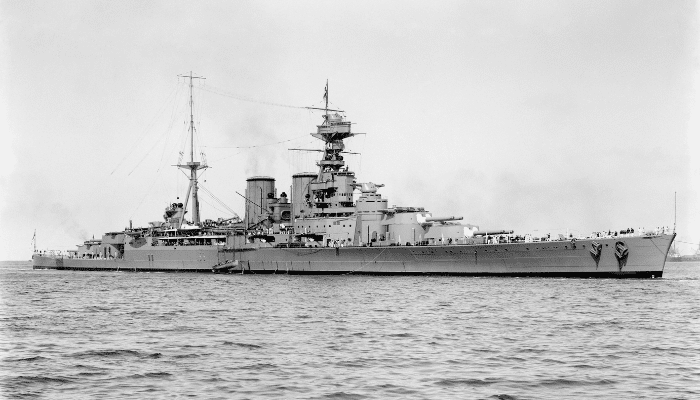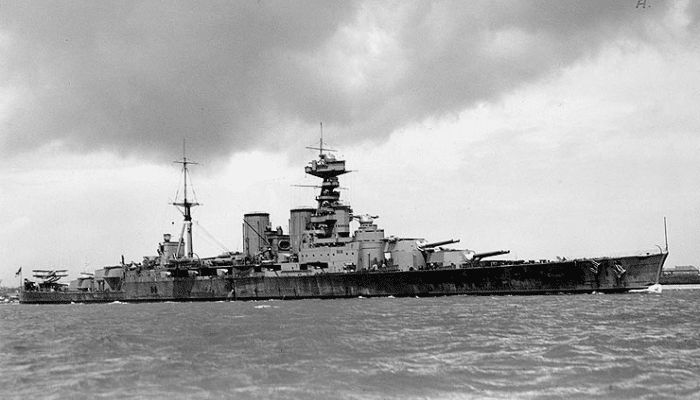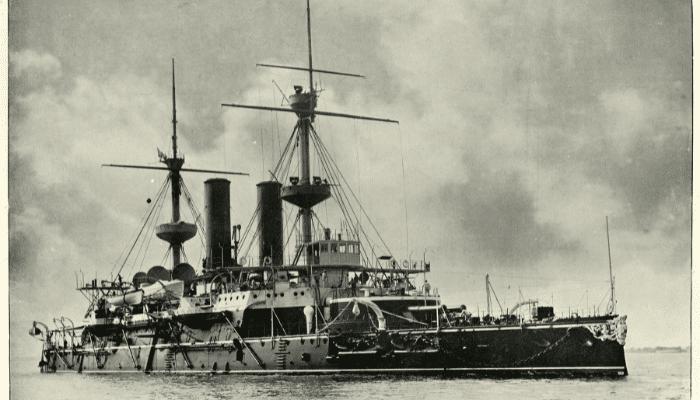10 Facts About the Mighty HMS Hood
HMS Hood was the Royal Navy’s Battlecruiser. She held the title of the world’s largest warship for two decades after being commissioned, with her prestige reflected in the nickname ‘The Mighty Hood.’
With her twin funnels and a lean profile, she was one of the finest-looking warships at that time. Due to her sheer size, power and contribution to several Royal Navy victories in the World War Years, she became synonymous with the might of the British Empire.
Read along to learn 10 interesting facts about HMS Hood in this article.
1. Design and Construction of HMS Hood
An Admiral-Class Battlecruiser, HMS Hood, was ordered during World War I from Clydebank Shipyard of Jon Brown- shipyard no.460.
She had an LOA of 262.3 m, a beam of 31.8 m and a 9.8 m draught. The Hood was 20.1 m longer and 4.3 m wider than earlier ships of the same type.
The ship’s 144,000 horsepower steam engines could take her to battle at 32 knots while her guns could throw a one-tonne shell 17 miles. She was envisaged to be larger, faster and more heavily armed than her predecessors.

However, when her keel was to be laid, three such vessels of the Royal Navy were lost in the 1916 Battle of Jutland, unveiling the flaws in the British Battlecruisers’ design. The Admiralty delayed her construction to make revisions to her design, which included the addition of about 4000 tonnes of armour, making it comparable with contemporary battleships.
Although four such battlecruisers were to be built, only Hood could be completed. Constructing ships was extremely expensive, and labour and materials were put into building merchant ships since many were lost to the German U-Boat Campaign.
2. Called ‘ the largest submarine in the Navy’
HMS Hood was quite stable. However, the additional armour increased her draught by 1.2 m at a deep load. This decreased her freeboard, and when moving at maximum speed or in heavy seas, water entered over its quarterdeck, mess decks and even the living areas via ventilation shafts.
The ship was quite damp, so it was called the largest submarine in the Navy. Also, ventilation was poor, which led to several cases of tuberculosis among sailors onboard the HMS Hood.
Her complement varied throughout her career. 1934, she carried 1433 men; in 1934, she had 81 officers and 1244 ratings. HMS Hood also carried fuel oil to give her a 7500 nm range at 14 knots.
3. Flagship of the Battlecruiser Squadron
After it was commissioned on 15th May 1920, HMS Hood became the flagship of the Battlecruiser Squadron of the Atlantic Fleet.
She went to Scandinavian waters the same year, and in 1921 and 1922, she visited the Mediterranean to show the flag and train with the Mediterranean Fleet. She then headed to Brazil and the West Indies with the Battlecruiser Squadron. She also participated in several fleet exercises to test British naval tactics.
While she did not engage in a major naval combat, her presence deterred the German High Seas Fleet from engaging the British Grand Fleet. It also helped in the British occupation of Istanbul/Constantinople in 1920.
4. Role In Second World War
When the Second World War broke out, HMS Hood was already two decades in commission, and due to her engagements, she had not undergone a major refit and upgrade. She operated near Iceland and spent many months searching for German raiders and blockade runners in the Norwegian Sea.
After a short overhaul of her propulsion system, she became the flagship of Force H and destroyed the French Fleet in the battle of Mers el Kebir in 1940. She also participated in operations off Norway to prevent Germany from invading Norwegian Ports. It also provided naval gunfire support for Allied troops on land.
After this, she was transferred to the Home Fleet and sent to Scapa Flow. She was a convoy escort and a defence against a potential German invasion fleet. Hood patrolled the Northern Waters to check for any suspicious German naval movement.
In 1941, she was deployed from Scapa Flow to stop the new German Battleship Bismarck, which was said to have left Norway on a raiding mission in the Atlantic.
5. HMS Hood And Bismarck- Battle of Denmark Strait
Bismarck left for the Atlantic in May 1941, and HMS Hood, along with the battleship Prince of Wales, was deployed to intercept it before the German Battleship could attack the Allied convoys in the Atlantic.

British Heavy Cruisers Norfolk and Suffolk spotted the German Ships. On 24th May, Hood intercepted Bismarck and her consort, the heavy cruiser Prince Eugen, in the Denmark Strait between Greenland and Iceland.
6. The Sinking of the Mighty HMS Hood
The Germans were aware of the British Ships’ presence since Prince Eugen’s hydrophones had already detected the sounds of propellors to the southeast. The British opened fire, and the German ships concentrated on Hood. A shell landed on Hood’s boat deck between her funnels and started a massive fire among the ammunition.
As Hood turned to reveal her rear turrets, she was hit again on the boat deck by a shell from Bismarck’s fifth salvo. Flames burst near the mainmast, leading to a magazine explosion, which destroyed the ship’s aft. It sank quickly, and the last sight of Hood was her bow, almost vertical in the water.
Out of 1418 men onboard Hood, only three survived. The three men, Ordinary Signalman Ted Briggs, Able Seaman Robert Tilburn, and Midshipman William John Dundas, were saved 2 hours after the Hood had sunk. They were found by Destroyer Electra.
This engagement ended the career of the Hood and the lives of 1415 men, the largest ever loss of life on any Royal Navy Warship. The loss of HMS Hood resonated far and wide. It was a dent in British morale, which made it imperative that Bismarck be destroyed. Hence, three days later, Bismarck was hunted down and sunk by the Royal Navy.
7. Remembering the HMS Hood & its 1415 Crew Members
About 1415 sailors lost their lives when HMS Hood sunk, leaving a void for many families. The HMS Hood Association was founded in 1975 to remember and honour the crew of HMS Hood.
It was founded by veterans who served in the battleship before her last journey, supported by the three sailors who survived the sinking and some of the family members of those who lost their lives.
The Association continues to grow as membership is open for all. It currently has around 400 members.
HMS Hood Association sponsored a half-hour movie called ‘For Years Unseen’. It is about the recovery of Hood’s Bell from the wreck by David Mearns in 2015. The film is available on YouTube and has garnered 600,000 views.
8. Finding the Wreck of HMS Hood
In 2001, Channel 4 reached out to shipwreck Hunter David Mearns and his company to find the wreck of HMS Hood. The channel wanted him to make underwater footage of the ship and her attacker, Bismarck, to be used in a documentary for the 60th anniversary of the battle.
After collecting footage of the Bismarck, Mearns and his team chose a 2100 km2 search area and, using side-scan sonar, found the wreck of HMS Hood. It was located at a depth of 2800 m, broken into pieces, scattered across two debris fields.
The biggest surviving section was the amidships section. Other pieces of the stern, bow and conning tower were also identified.
The wreck lies in the Irminger Basin of the Denmark Strait between Iceland and Greenland. In 2002, the UK designated the wreck as a protected war grave.
9. Expedition to retrieve HMS Hood’s Bell
The British Government sought Mearns again in 2012 to retrieve one of Hood’s two bells, which would serve as a memorial reflecting the sacrifice of her last crew members in the battle. It was decided to be displayed at the National Museum of the Royal Navy.
Mearns and his team returned to the resting place of Hood, refilmed the wreck, and surveyed it again. Hood’s Bell was finally retrieved in 2015 and unveiled in 2016, on the 75th anniversary of the Battle of Denmark Strait.

A commemorative service was held where the bell was rung eight times. It was attended by descendants of the ship’s last crew. The bell was then kept in the museum’s exhibit showcasing the Battle of Jutland.
10. Surviving Relics from the HMS Hood
A few relics from the HMS Hood still exist, including a massive piece of the wooden transom from one of its boats that floated to Norway after her sinking. It is preserved in the National Maritime Museum, London.
A metal box with administrative papers was found after it was washed ashore on the Island of Senja in 1942, a year after the Battle of Denmark Strait. The container and its contents were lost. However, its lid was found and handed to the Royal Navy establishment HMS Centurion in 1981.
Two 5.5-inch guns of HMS Hood were removed during its 1935 refit. They were sent to Ascension Island, where they were installed as a shore battery in 1941. The guns sit on a hill above the port and the settlement of Georgetown, where they remain.
The guns saw action just once in 1941 when they were fired on a German Submarine U-124. The submarine was approaching Georgetown to either shell the cable station or attack ships at anchor. The guns missed the target, and the submarine retreated.
Conclusion
The sinking of the Mighty Hood was a significant loss for the Royal Navy since she was considered the most powerful battle Cruiser in the world then. Though HMS Hood sank after being hit by the German Battleship Bismarck, its crew courageously until the very end.
The loss of Hood taught valuable lessons regarding battlecruiser design and armour protection that the Royal Navy implemented in future warship construction.
The wreck of HMS Hood was found in 2001, and one of her bells was retrieved in 2012. Her wreckage site was also declared to be a protected war grave by the government. Hood remains a symbol of British Naval Power, and the HMS Hood Association continues to carry the Hoods’ legacy forward.
You might also like to read-
- 8 Major U.S East Coast Ports
- 8 Major Ports of Marshall Islands
- 10 Major Indian Navy Vessels
- 10 Major Ports Of Greece
- 10 Longest Fjords In The World
Disclaimer: The author’s views expressed in this article do not necessarily reflect the views of Marine Insight. Data and charts, if used in the article, have been sourced from available information and have not been authenticated by any statutory authority. The author and Marine Insight do not claim it to be accurate nor accept any responsibility for the same. The views constitute only the opinions and do not constitute any guidelines or recommendations on any course of action to be followed by the reader.
The article or images cannot be reproduced, copied, shared or used in any form without the permission of the author and Marine Insight.
Do you have info to share with us ? Suggest a correction

About Author
Zahra is an alumna of Miranda House, University of Delhi. She is an avid writer, possessing immaculate research and editing skills. Author of several academic papers, she has also worked as a freelance writer, producing many technical, creative and marketing pieces. A true aesthete at heart, she loves books a little more than anything else.
Subscribe To Our Newsletters
By subscribing, you agree to our Privacy Policy and may receive occasional deal communications; you can unsubscribe anytime.



